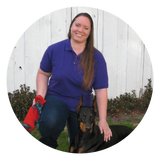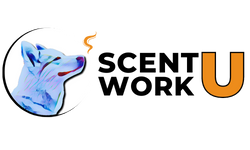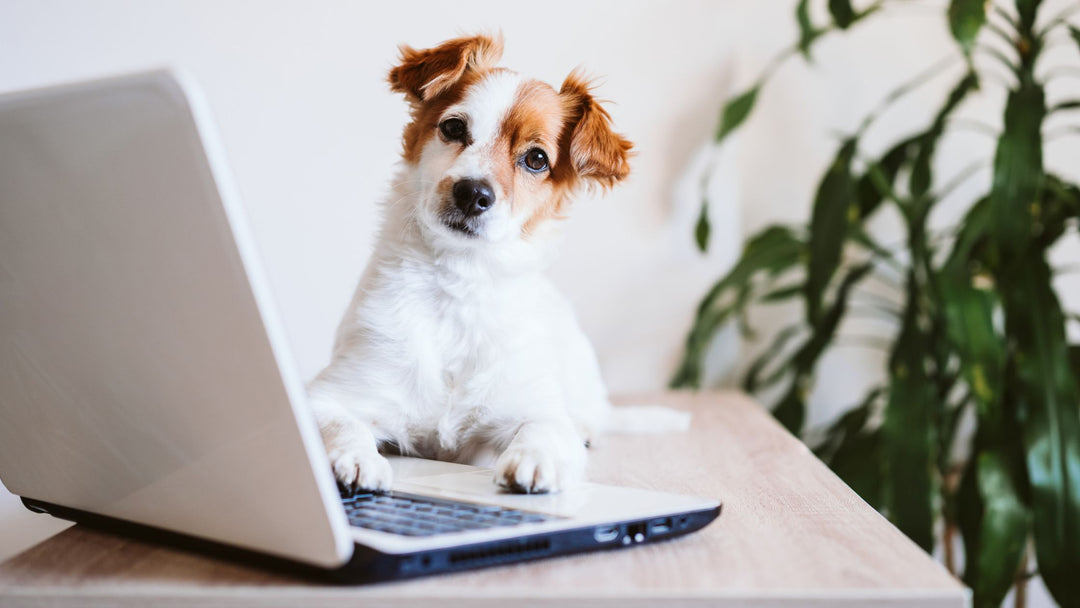Breaking Down "The Search"

Scent Work is an intriguing dog sport, standing in stark contrast to many of the alternatives. One distinguishing feature is how challenging it can be for us as handlers and trainers to identify the various components which make up “the search”. This causes us to do “all the things” simultaneously, which can backfire spectacularly. Should something go wrong, it is close to impossible to extrapolate what that is as there are way too many variables! Or if only one tiny feature needed to be finessed but we instead took a sledgehammer to the entire thing, this can cause serious fallout.
To help this make more sense, let’s take a look at a few other dog sports and evaluate how we may tackle those when training and prepping for trial.
In agility, the ultimate goal is to run a course of various obstacles with our dog. It would be ludicrous to assume our very first exposure to agility would consist of us and our dogs running full tilt around a 24 obstacle course! There are countless individual skillsets that must first be mastered on behalf of the dog, the handler and how they work together as a unit.
For starters, we must ensure our dog can actually focus on us when off leash in a large area. The first few training sessions may be devoted to building the dog’s attention on us, working in the same area where our agility class or training will ultimately take place. This can also be done with fellow classmates working, desensitizing the dogs to working around one another. On a parallel path, another set of exercises may build the foundation pieces of your start line stay or even work on building the dog’s proprioception which can be used later to build a rear foot target, helpful for contact obstacles such as the A-frame, dog walk and teeter.
From there, you may work on wraps and send outs using a cone or jump stanchion. This is incorporating dog and handler skills, where you are learning ways to use your body to better communicate to the dog what you are looking for. If all this is going well, you may progress to adding in a pole on the ground for the dog to move over. Then slightly elevate this pole, watching their form and making any necessary adjustments to prevent them from merely flinging themselves over the obstacle. All the while, you are breaking this down into the tiniest of components, parsing out what works, what needs work and which of you is the primary target of a given exercise: the dog, you as the handler or the team as a unit.
The point being, none of this even slightly resembles a full on 24 obstacle agility course, yet is essential if you hope to ever run a full course well. Why then is it that we assume we can simply leap into a full on search in all of our training and not experience any fallout?
Not convinced yet? Consider flyball. Dog runs down a lane, leaping over a few low hurdles, hits a ball launcher, retrieves said ball, turns and races back down the lane as fast as they can where they meet up with their handler holding a tug the dog finds even more reinforcing than the ball. This simple explanation highlights the various components which make up flyball as an activity, any of which may need to be parsed out and addressed individually. Essentially a giant behavior chain, each individual behavior must be solid and mastered. Otherwise, the chain can break down.
For instance, if the behavior of retrieving the ball is not strong enough, the dog may merely parkour off the launcher, spin around without getting the ball and race back with hopes of getting their tug. The answer to this problem would be to isolate and strengthen the ball retrieving piece, then weaving it back into the larger sequence of the behaviors, not attempting to do full runs over and over and over again.
Yet in Scent Work, we want all the things, all the time.
Have a dog who is struggling with frustration which leads to aggressive alerts? A typical response is to design a search with multiple hides, wait for the dog to offer their final trained response and then try to get in quickly to reward, hoping to preempt the aggressive alert.
Another example is coping with a dog who abandons puzzles without solving them. No worries, simply walk over and ask the dog to better detail that area.
What’s the issue, you may ask. Well, these approaches are failing to take into account the core problem. Instead, they are lumping, doing all the things at once, as opposed to breaking the sequence down into the smallest possible components.
For the dog who is offering aggressive alerts upon becoming frustrated, shouldn’t the first task be to figure out WHY they are getting frustrated? We could then devise exercises specifically designed to improve their frustration threshold both within and outside the context of Scent Work.
Regarding the aggressive alert itself, this is a behavior we wish to curtail. The goal is for the dog to grasp they only need to find the hide, this other stuff such as pawing or biting at the hide is unnecessary. How can we accomplish this? Set out a single hide with the plan of rewarding the dog the moment they find it. However, this not be a formal search. Rather, the hide will be clearly visible and accessible to the dog, where they know where it is before we release them. Why? Our issue is not the hunt or seek part of the sequence, it is what the dog thinks they must do when they find the hide. Why not focus just on that? Once the dog grasps that feet and teeth are not necessary, then we can once again work on the hunt or seek part, looking for what is working and what may still need work.
What about the dog who abandons puzzles before solving them? Injecting ourselves into the picture is likely making the problem worse. Again, we should start by evaluating the why. Why is the dog abandoning this puzzle? Do they lack the requisite skills to solve it? Or, have we inadvertently built in an expectation in the dog that they can obtain an answer to any question within 10 seconds and if they don’t, no worries, there is an easier option out to find!
A better solution likely does not entail running giant full sequence searches to death. Rather, parsing out the piece that needs attention. Offer a single hide puzzle that will take 20 seconds for the dog to solve and simply wait them out to do so. Perhaps pair the hide so the dog can immediately self-reward upon being correct. They may have felt in a tinge of frustration, but when they powered throguh, voila, here is their reward. In that moment, they learned working through their frustration, as opposed to giving up the puzzle entirely, worked. You can then incrementally build the level of challenge for this single hide. However, take care to be variable. Meaning sometimes the dog must work for over 2 minutes to solve this singular puzzle whereas other times they can solve it in less than 5 seconds. When you are seeing the level of focus and tenacity you are looking for, then incorporate a second hide, being ready and willing to go back a step should the dog quit on either puzzle.
It is paramount for us to not only recognize each individual component which makes up "the search" but also grasp how each requires our attention, focus and care. Should we choose to train a final trained alert, this behavior is a new and separate component that must first be built and then regularly maintained over the course of our dog's sniffing career. Does this mean in every single search we should wait for our dog to offer a final trained alert response? Absolutely not! There are times when we must focus more on the hunt or seek part of the sequence or we may want to capture and reward the dog's sourcing behavior. Our human brain wants us to capture the full search every single time we train or practie, but our experience in other dog sports shows us this is not the best approach to take.
What are you trying to work on and how can you do so without trying to do “all of the things?” Start with these big bucket possibilities and think of ways you can further break them down or design exercises which build the requisite skills:
- Dog’s value in odor
- Dog’s odor obedience
- Dog’s hunt drive
- Dog’s resiliency
- Dog’s tenacity
- Dog’s confidence
- Dog’s independence
- Dog’s ability to work a specific odor puzzle
- Dog’s ability to cope with the environment
- Dog’s understanding of the game
- Your start line routine
- Your ability to read your dog
- Your overall observational skills
- Your on-leash handling skills
- Your off-leash handling skills
- Your reward timing
- Your reward mechanical skills
- Your ability to cover a space
- Your ability to keep track of where you have been
- Your ability to understand the environmental factors
- Your mental management skills
- The team’s fluidity
- The team’s efficacy
- The team’s communication
- The team’s efficiency
Are you looking for help regarding aggressive alerts? Check to these resources:
- Aggressive Alerts: Causes and Solutions Webinar with Tony Gravley
- Box Smashers Webinar with Dianna L. Santos
- Nose Poke Alert Webinar with Holly Bushard
- Train a Freeze Indication Webinar with Michele Ellertson
Does your dog have frustration threshold issues? You may be interested in these resources:
- My Head Hurts: Dealing with Frustration Threshold in Scent Work Webinar with Dianna L. Santos
- Click to Calm: Turning Fear and Frustration Into Focus Through Positive Reinforcement Webinar with Emma Parsons
- Keep Your Head: Maintaining Good Arousal in Nosework Webinar with Michele Ellertson
- Masterful Mazes Webinar with Dianna L. Santos
- Mastering Multiple Hides Webinar with Michael McManus
Looking for a more in-depth discussion regarding the various components of Scent Work? Check out this webinar series:
- Components of Scent Work: Value of Odor Webinar
- Components of Scent Work: Hunting Webinar
- Components of Scent Work: Odor Obedience Webinar
- Components of Scent Work: Sourcing Webinar
- Components of Scent Work: Dog Communication Webinar
- Components of Scent Work: Handler Communication Webinar

Dianna has been training dogs professionally since 2011. She has done everything from teaching group training classes and private lessons, to specializing in working with fearful, reactive and aggressive dogs, to being a trial official and competition organization staff member.
Following a serious neck and back injury, Dianna was forced to retire from in-person dog training. But she was not ready to give up her passion! So, she created Pet Dog U and Scent Work University to provide outstanding online dog training to as many dog handlers, owners and trainers possible…regardless of where they live! Dianna is incredibly grateful to the amazingly talented group of instructors who have joined PDU and SWU and she looks forward to the continued growth of PDU and SWU and increased learning opportunities all of these online dog training platforms can provide.
In June 2021, Dianna and her business partner, Sean McMurray launched Cyber Scent Work, an organization that operates in the gray space between training and trialing in Scent Work. With Cyber Scent Work, handlers have the opportunity to earn Qs, titles and ribbons while also receiving helpful training advice regardless of whether they qualify or not! The advent of the Cyber Sniffing Games, Traditional Cyber Scent Work Program, in-person and online assessments have been met with much fanfare! Be sure to check out Cyber Scent Work, you will be happy you did!
Join Our Newsletter
Stay up to date with all the happenings at Scent Work University, including the release of new online courses, seminars, webinars, eBooks and receive exclusive promotions and discounts!


